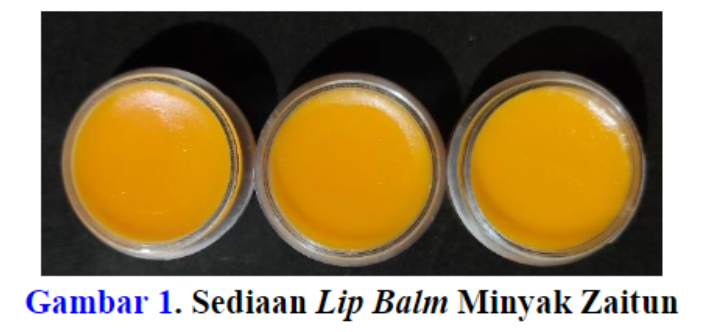Main Article Content
Abstract
Lip balm is a preparation that is applied on the lips to protect the lips from damage. Olive oil is an oil that has emollient properties that are able to maintain moisture, flexibility, and smoothness in the skin. Oleic acid content in olive oil has the ability to improve skin permeability. Tengkawang fat is known to have characteristics similar to cocoa fat so it is used as a base. This study will provide an overview of the physical properties of olive oil lip balm (olive oil) with tengkawang fat based on storage for 28 days. Lip balm preparations are made in three concentration variations for 10%, 15%, and 20%, Then the preparation will be observed organoleptically changes, homogeneity of the preparation, pH and temperature of the melting point. The results ANOVA test of pH showed there was no significant difference between storage time to pH for each formula. Organoleptic and homogeneity test show good results in the absence of discoloration, odor, and texture and homogeneity during the storage period. The evaluation of lip balm preparations for each formula showed that the preparations were physically stable during the 28-day storage period.
Keywords
Article Details

This work is licensed under a Creative Commons Attribution-NonCommercial 4.0 International License.
References
- Adliani N, Nazliniwaty, Purba D. (2012). Formulasi lipstik menggunakan zat warna dari ekstrak bunga kecombrang (Etlingera elatior (Jack) R.M.Sm.). Journal of Pharmaceutics and Pharmacology. 1(2).91.
- Agustiana YD, Herliningsih. (2019). Formulasi sediaan lip balm dari minyak zaitun (Olive oil) sebagai emolien dan penambahan buah ceri (Prunus avium) sebagai pewarna alami. Journal of Herbs dan Farmacological. 1(1).24–7.
- Kusharto CM, Srimiati M, Tanziha I, Suseno SH. (2015). Efek penambahan vitamin E terhadap stabilitas minyak ikan lele. Jurnal Pengolahan Hasil Perikanan Indonesia. 18(3).321–2. DOI: 10.17844/jphpi.2015.18.3.321
- Kusumaningtyas V, Sulaeman A, Yusnelti. (2012). Potensi lemak biji tengkawang terhadap kandungan mikroba pangan pada pembuatan mie basah. Bionatura Jurnal Ilmu-ilmu Hayati dan Fisik. 14(2).143.
- Leksono B, Hakim L.(2018). Keragaman kandungan lemak nabati spesies shorea penghasil tengkawang dari beberapa provenans dan ras lahan. Jurnal Ilmu Kehutanan. 2(2).213.
- Nazliniwaty, Laila L, Wahyuni M. (2019). Pemanfaatan ekstrak kulit buah delima (Punica granatum L.) dalam formulasi sediaan lip balm. Jurnal Jamu Indonesia. 4(3).87–92.
- Nurany A, Amal ASS, Estikomah SA. (2018). Formulasi sediaan lipstik ekstrak bunga rosella (Hibiscus sabdariffa) sebagai pewarna dan minyak zaitun (Olive oil) sebagai emolien. Pharmasipha. 2(1). 1–5.
- http://dx.doi.org/10.21111/pharmasipha.v2i1.2135
- Rowe RC, Sheskey PJ, Quinn ME. (2009). Handbook of pharmaceutical excipients. sixth edition. Pharmaceutical Press. USA. 75–76, 442–443, 470–471, 592–593, 772–773.
- S, Selfia M, Azhar R. (2014). Studi kestabilan fisika dan kimia dispersi padat ketoprofen–urea. Jurnal Farmasi Higea. 6(1). 162–3.
- Warnida H, Sukawaty Y, Ardhita FW. (2020). Perbandingan fisik formula lipstik dengan basis lemak tengkawang (illipe butter) dan lemak coklat (cocoa butter). Jurnal Ilmiah Manuntung. 6(1).103–9. https://doi.org/10.51352/jim.v6i1.322
- Yulyuswarni. (2018). Formulasi ekstrak kulit buah naga merah (Hylocereus polyrhizus) sebagai pewarna alami dalam sediaan lipstik. Jurnal Analis Kesehatan. 7(1).678.
- Yusuf NA, Hardianti B, Lestari IA, Sapra A. (2019). Formulasi dan evaluasi lip balm liofilisat buah tomat ( Solanum Lycopersicum L .) sebagai pelembab. Jurnal Ilmiah Manuntung,. 5(1), 115–8. https://doi.org/10.51352/jim.v5i1.244
- Zaini AN, Gozali D. (2016). Pengaruh suhu terhadap stabilitas obat sediaan suspensi. farmaka. 14(2).1–2. https://doi.org/10.24198/jf.v14i2.10820
